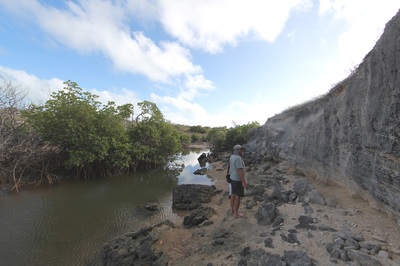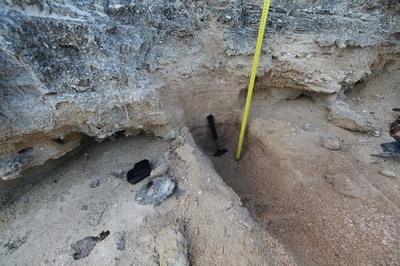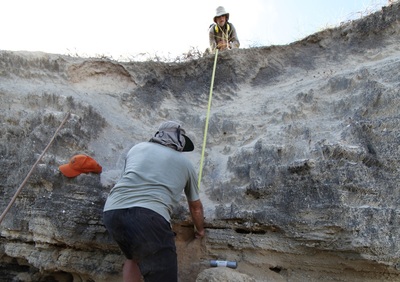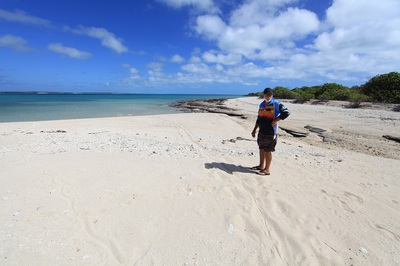
Dr Tim Stone emerges after inspecting the creek from which the samples were taken. Momentarily distracted by a mob of Little Corellas - Tim is going to rendezvous with the boats which are waiting at the mouth of the creek. This at the NE corner of Two Island Bay on the western side of Marchinbar Island. An Archaeologist, Geologist, Geomorphologist & Geochronologist - Tim is sampling buried silica sand from the earliest levels of deposition. This Optically Stimulated Luminescence {OSL} 'beach dating' is the first such analysis performed in northern Australia. The samples are to be processed at Dr Matt Cupper's laboratory at Melbourne University where he & Tim dated the sands trapped in the barrel of the swivel gun found by Christopher Doukas at Dundee Beach. Until relatively recent times such practices would have been rewarded with a trip over the falls in a barrel - Tim & Matt in conjunction with other alchemists at Melbourne & ANU are pioneering the application of geochronological techniques for archaeological applications.
The procedure involves the insertion of a section of 40mm pvc pipe into the section of beach carved by the creek. This prevents light reaching the entombed silica sand particles which are compared to the exposed sands on the end of the tube. Tim's short article below explains the HIR process of 'land rise' exemplified by the image of a stranded shoreline on Marchinbar Island.
The procedure involves the insertion of a section of 40mm pvc pipe into the section of beach carved by the creek. This prevents light reaching the entombed silica sand particles which are compared to the exposed sands on the end of the tube. Tim's short article below explains the HIR process of 'land rise' exemplified by the image of a stranded shoreline on Marchinbar Island.

This image is to the right of the stranded beach is from Google Earth - 1.5 miles south of Sphinx Head on the western side of Marchinbar Island in the Wessels at 11 degrees 12.709' S - 136 degrees 42.356' E - it is possible that such a 'land rise' event happened as recently as one thousand years ago.
Whilst the geological origins of the land are of immense fascination to the Yolngu people and a core subject of Past Masters Workshops - it is the combination of scientific analysis and oral history that points the direction for research as the bulk of Yolngu archaeology has been submerged by millennia of steady sea rise.
It is hoped that these technologies will test the theory that a southern hemisphere equivalent of the 'Little Ice Age' caused sea levels to fall during the first half of the 17th century with the effect of briefly opening a land bridge between PNG and Cape York and accounting for the Dutch crew of the Arnhem & Pera reporting the western end of Torres Strait as a dry river mouth - shown on their chart as rocks and sandy gravel.
Whilst the geological origins of the land are of immense fascination to the Yolngu people and a core subject of Past Masters Workshops - it is the combination of scientific analysis and oral history that points the direction for research as the bulk of Yolngu archaeology has been submerged by millennia of steady sea rise.
It is hoped that these technologies will test the theory that a southern hemisphere equivalent of the 'Little Ice Age' caused sea levels to fall during the first half of the 17th century with the effect of briefly opening a land bridge between PNG and Cape York and accounting for the Dutch crew of the Arnhem & Pera reporting the western end of Torres Strait as a dry river mouth - shown on their chart as rocks and sandy gravel.
Your browser does not support viewing this document. Click here to download the document.


















